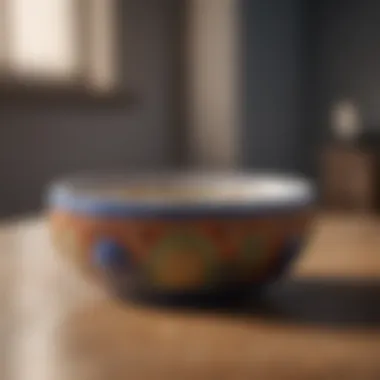Choosing the Right Dog Bowl Material: A Detailed Evaluation


Intro
Selecting the right dog bowl is fundamental for the health and well-being of your pet. This decision involves more than just aesthetics; the material used for the bowl can significantly affect a dog's eating habits, safety, and overall health. As various options become available in the pet market, understanding the pros and cons of each material is essential for pet owners and professionals alike.
In this comprehensive guide, we delve into the most common materials used for dog bowls, including stainless steel, ceramic, plastic, and silicone. We will explore their durability, safety, ease of cleaning, and how they influence canine health. By the end, readers will be better equipped to make informed decisions tailored to their unique needs.
Fascinating Facts About the Dog
Understanding dogs go beyond their materials and bowls. They have unique characteristics that distinguish them in the animal kingdom. For instance, dogs are known for their acute sense of smell, which is more than 10,000 times more sensitive than that of humans. This ability influences not just their behavior but also their interactions with objects, including their food bowls.
Unique Characteristics
- Diverse Breeds: Dogs come in various breeds, each with unique traits. Some breeds have a strong eating drive, while others are picky eaters.
- Social Creatures: Dogs thrive in social environments and often require specific settings to eat comfortably. This can affect the type of bowl they feel more at ease using.
Extraordinary Abilities
- Communication Skills: Dogs can express their needs non-verbally. For instance, they may nudge their bowls if they want food or water.
- Training Potential: Many dogs can be trained to use specific bowls or even adjust their behavior based on bowl design. This adaptability can impact the owner's choice in materials.
Material Overview
The material of a dog bowl plays a crucial role in the dog's eating experience. Here’s a closer look at the popular options.
Stainless Steel
Stainless steel dog bowls are durable and resistant to slipping. They are also dishwasher safe, making them easy to clean. Moreover, stainless steel does not absorb odors or bacteria, which is essential for maintaining a safe feeding environment.
Ceramic
Ceramic bowls often offer aesthetic appeal and can come in various designs. However, they can chip or break easily, which poses a safety hazard. If choosing ceramic, ensure they are lead-free to protect your dog's health.
Plastic
While plastic bowls are lightweight and inexpensive, they tend to scratch easily and can harbor bacteria. They can also leach harmful chemicals over time. Therefore, maintaining cleanliness is crucial when using plastic bowls.
Silicone
Silicone bowls are flexible and portable. They are ideal for travel but may not provide the stability that some dogs need during mealtime.
Epilogue
This detailed examination of dog bowl materials shows that the choice impacts more than just style. Each material holds distinct advantages and disadvantages. By evaluating these factors, pet owners can better ensure their dogs have safe and comfortable eating experiences. Understanding how material affects health, safety, and hygiene is vital for anyone looking to provide the best for their fur companions.
Preamble to Dog Bowl Materials
Choosing the appropriate material for your dog's bowl may seem like a minor decision. However, it has far-reaching effects on your pet's health and overall eating experience. This introductory section delves into the significance of selecting the right dog bowl material, guiding readers through the various options available.
Importance of Choosing the Right Material
Selecting the right material for a dog bowl impacts several critical factors. First, it influences your dog's safety. Some materials can leach harmful chemicals, while others may harbor bacteria if not cleaned properly.
Moreover, the bowl's durability affects not only its lifespan but also its usability. For example, a less durable material may break easily, leading to injury for your pet. Then, there is the comfort level of your dog while eating. Some materials may make it easier for the dog to consume food and drink, while others might not be as functional.


Additionally, ease of cleaning plays a vital role. Dogs are likely to make a mess while eating, and a bowl that is simple to clean can save you time and effort. Understanding these aspects helps to choose wisely, keeping your dog's best interests in mind.
Overview of Popular Materials
In the market, several dog bowl materials are commonly available, each with its own characteristics. They include:
- Stainless steel: Known for its durability and ease of cleaning, this material is quite popular among pet owners.
- Ceramic: These bowls often come in various colors and designs, offering aesthetic appeal. However, they may chip or break easily.
- Plastic: Often the most affordable option, plastic bowls offer variety but can harbor bacteria and don't last as long as other materials.
- Silicone: Flexible and easy to transport, silicone bowls are becoming more favored for their portability and ease of use.
This overview sets the stage for a more detailed exploration of these materials in the following sections, aiding pet owners in making informed decisions tailored to their dog's specific needs.
Stainless Steel Bowls
Stainless steel bowls are a paramount consideration in the assessment of dog bowl materials. Their composition accounts for various important characteristics, such as durability, safety, and ease of maintenance. Many pet owners regard them as a top choice when selecting a bowl for their dogs. Understanding the specific attributes of stainless steel can significantly influence decision-making when considering the best options for canine feeding.
Durability and Longevity
One of the standout features of stainless steel bowls is their remarkable durability. Unlike materials like plastic or ceramic, stainless steel does not crack or chip easily. This resilience makes it highly suitable for both indoor and outdoor use. Furthermore, stainless steel is resistant to rust and corrosion, ensuring a long lifespan even in adverse conditions.
Moreover, this material withstands the test of time, reducing the need for frequent replacements. Many pet owners appreciate that investing in a stainless steel bowl means fewer trips to the store for replacements. The longevity of these bowls can be financially advantageous as well, particularly for those with multiple pets.
Safety Considerations
Safety is paramount when choosing any feeding equipment for dogs. Stainless steel bowls are non-porous, which means they do not absorb odors or bacteria. This quality minimizes the risk of cross-contamination that can occur with plastic bowls, which often show signs of wear and harbor germs in scratches. Additionally, high-quality stainless steel is typically free from harmful chemicals like bisphenol A (BPA), which is often found in certain plastics.
However, it is important to note that not all stainless steel bowls are created equal. Pet owners should look for food-grade stainless steel that guarantees safety and health for their pets. Bowl aspects should also be inspected thoroughly to avoid any sharp edges or poorly constructed seams that could potentially hurt pets.
Cleaning and Maintenance
Maintaining cleanliness in dog bowls is crucial for your pet's health. Stainless steel has a distinct advantage here, as it is dishwasher-safe and can endure high temperatures without warping. Cleaning stainless steel bowls is a straightforward process. Usually, a simple rinse with hot soapy water works, and more difficult stains or residues can be removed effortlessly with a non-abrasive sponge.
In contrast to plastic bowls, which can discolor or retain odors, stainless steel can easily be wiped clean, leaving little chance for bacteria to thrive. Regular cleaning not only benefits your pet's health, but it also prevents unsightly buildup that can occur over time.
Ceramic Bowls
Ceramic bowls are a popular choice among dog owners for several reasons. Their unique characteristics merit a closer look. Understanding the benefits and potential drawbacks of ceramic dog bowls is crucial for making informed purchasing decisions. While they often serve a functional purpose, the aesthetic appeal, risk factors, and health implications involved in ceramic materials can significantly influence your choice.
Aesthetic Appeal
One of the most appealing aspects of ceramic dog bowls is their aesthetic versatility. These bowls come in a variety of colors, designs, and finishes, which can complement any home decor. Many pet owners appreciate the option to choose a bowl that matches their personal style or home environment. The smooth and glossy finish of ceramic can create a pleasing presentation while serving its practical purpose.
Moreover, since ceramic bowls are often designed with artistic elements, they can be a decorative addition rather than only a tool for feeding pets. This aesthetic factor can elevate the experience of pet ownership beyond mere functionality. Some manufacturers even offer custom designs, allowing pet owners to personalize their dog’s dining experience.
Risk of Chipping and Breakage
Despite their visual appeal, ceramic bowls are susceptible to damage. The material can chip or break if dropped or subjected to vigorous use, which poses a concern for both pet safety and the bowl's longevity. Once a ceramic bowl chips, it may harbor sharp edges that could potentially injure your dog. Furthermore, a broken bowl often necessitates replacement, sometimes leading to higher long-term costs compared to more durable materials.
To mitigate these risks, consider the lifestyle of your dog. If you have a particularly active or clumsy pet, opting for a ceramic bowl might not be the best choice. Those with calmer behaviors may find ceramic bowls a suitable option, as they can maintain the integrity and aesthetic of their feeding experience.
Glazes and Health Concerns
Another significant consideration in the context of ceramic dog bowls is the glaze used during manufacturing. Certain glazes may contain harmful chemicals, such as lead, raising serious health concerns for pets. Not all ceramic bowls are created equal; some are labeled as food-safe, while others may not adhere to safety standards. It is essential for dog owners to research and select bowls that are certified as non-toxic and free from harmful substances.


Moreover, regular cleaning of ceramic bowls is necessary to prevent bacterial growth. While the smooth surface of ceramic is easy to clean, any wear or scratching can compromise its ability to remain hygienic. The bottom line is that, while ceramic bowls can be visually appealing and functionally adequate, their selection must be approached with caution regarding both durability and safety.
In summary, ceramic bowls can offer an attractive feeding solution, but potential risks such as chipping, breakage, and health concerns associated with glazes necessitate careful evaluation before making a purchase.
Plastic Bowls
Plastic bowls are a popular choice among dog owners due to their practicality and affordability. Their lightweight nature makes them easy to handle, whether at home or on the go. However, it is crucial to evaluate the pros and cons of plastic bowls to determine if they are the right fit for your pet's feeding needs.
Affordability and Variety
Plastic bowls are often more affordable than their metal or ceramic counterparts. This makes them an accessible option for pet owners on a budget. In addition to cost-effectiveness, there is a wide variety of colors, designs, and sizes available. This allows owners to choose a bowl that complements their home decor or suits their personal style. Whether you have a small dog or a larger breed, finding the right size is easy with plastic options.
However, too much variety can sometimes lead to confusion. Consider your dog's specific requirements, such as food preferences or allergy considerations, when choosing a bowl. Look also for bowls with non-slip bases, as these can reduce spills and keep the bowl in place during mealtime.
Durability Issues
Though plastic bowls have their advantages, they also come with notable durability issues. Over time, plastic can become scratched or worn down. These scratches may harbor bacteria, even after cleaning, which poses a health risk to your pet. Additionally, if dropped or subjected to pressure, plastic bowls are more likely to crack or break compared to stainless steel or ceramic alternatives.
Examine these bowls regularly for signs of damage. If you notice any deep scratches or discoloration, it may be time to replace the bowl. Consider investing in thicker, higher-quality plastic bowls that can withstand wear and tear better than standard options.
Chemical Concerns
One of the most significant drawbacks of plastic bowls is the potential for chemical leaching. Many lower-quality plastic products contain harmful substances, such as bisphenol A (BPA) or phthalates. These chemicals can leach into food or water, exposing your pet to potential health risks.
When selecting a plastic bowl, look for ones labeled as
Silicone Bowls
Silicone bowls offer a unique blend of practicality and versatility, making them an increasingly popular choice among pet owners. Their lightweight, flexible nature makes them ideal for various situations, from everyday feeding to travel. In this section, we delve into the specific advantages and considerations associated with silicone bowls, an often overlooked material in discussions about dog bowls.
Portability and Flexibility
One of the most significant advantages of silicone bowls is their portability. Unlike traditional materials, silicone is lightweight and collapsible, allowing for easy storage and transport. This feature is particularly beneficial for families on the move. When traveling or hiking, you can easily pack a silicone bowl in a bag or backpack without taking up much space.
Flexibility also plays a key role in usability. The ability to fold or roll up a silicone bowl means you can fit it into tight spaces or shape it to suit your pet's needs. It is less likely to crack or break under stress, making it a practical choice for active dogs or outdoor adventures.
Durability Under Pressure
Durability is crucial when selecting any dog bowl material, and silicone excels in this area. Silicone bowls can withstand substantial pressure without compromising their integrity. This durability is important for dogs that may chew on or aggressively bump their bowl during meals.
Unlike plastic, silicone does not warp or degrade over time, especially when exposed to heat. Its high resistance to both extreme temperatures and harsh cleaning products makes it suitable for both hot and cold food.
Cleaning and Care
Maintaining silicone bowls is quite simple, which is an important consideration for busy dog owners. Their non-stick surface helps prevent food residue from binding, allowing for easy rinsing. Most silicone bowls are dishwasher safe, enhancing convenience.
Nonetheless, some points should be kept in mind during cleaning. Although silicone is stain-resistant, it may still absorb certain strong odors over time if not cleaned properly. Regular washing with soap and warm water will help eliminate any lingering smells.
In summary, silicone bowls provide a valuable option for pet owners seeking flexibility, durability, and ease of cleaning. Understanding these benefits can assist in making a comparitive assessment, contributing to an informed decision when selecting the best material for your dog's bowl.
Factors to Consider in Bowl Material


Selecting the right bowl material plays a vital role in ensuring the well-being of your dog. Various factors influence the decision, making awareness of specific elements crucial when choosing a bowl. It is important to recognize how dog size and behavior, health considerations, and personal preferences impact this choice.
Dog Size and Behavior
The size and behavior of your dog is a central factor in choosing the right bowl material. Larger breeds often require sturdier materials that can withstand their weight and force. Stainless steel bowls might be more suitable. They offer stability and durability, resist tipping, and can handle aggressive eaters or drinkers. In contrast, small breeds may find ceramic bowls attractive due to their aesthetic charm.
Behavior also plays a role. A dog that tends to push their bowl around needs a heavier or non-slip option. In those instances, silicone mats or bowls with rubber bases are desirable. Considering how your dog interacts with their bowl helps in selecting the right material. It also ensures ease of use for the dog, making meal times more pleasant.
Health Considerations
Health is a major concern for every pet owner. The chosen material can genuinely impact a dog's health. For instance, plastic bowls can harbor bacteria and may lead to issues like acne or infections, especially in young dogs. Thus, it is advisable to opt for non-porous materials like stainless steel or ceramic.
Additionally, consider how easy it is to clean each type of bowl. A bowl that is dishwasher safe can simplify hygiene practices, ensuring your dog's feeding area remains clean. Some materials may react with certain foods or lead to chemical leaching, which could result in adverse health effects over time. Non-reactive materials like stainless steel are preferable.
Personal Preferences
Personal choices also factor into the decision. Aesthetic preferences can influence the selection of bowl material. Some individuals may value the look and feel of ceramic. Others might prefer the functional aspect of metal bowls. Additionally, portability is key if you travel with your dog. Silicone bowls, for instance, are easy to collapse and pack.
Another aspect to consider is environmental consciousness. Selecting sustainable materials, such as bamboo or biodegradable options, appeals to owners who prioritize eco-friendliness. Highlighting personal preferences can encourage owners to engage in healthy practices while ensuring both the dog and environment are taken care of.
Each material offers unique advantages and disadvantages, and weighing these can lead to a well-informed decision.
In summary, the factors influencing bowl material choice are not trivial. They encompass a range of considerations that relate to the dog's characteristics, health needs, and owner values. With a deeper understanding, each dog owner can navigate this choice thoughtfully.
Sustainable Options
Choosing dog bowl materials with sustainability in mind is crucial in today's eco-conscious society. Many dog owners are increasingly becoming aware of the environmental impact of their purchases. Selecting sustainable materials such as bamboo and biodegradable options can significantly reduce waste and contribute to a more ethical lifestyle. Sustainability is not just about using less plastic; it encompasses the entire lifecycle of the product from creation to disposal. Therefore, opting for sustainable dog bowls can lessen our carbon footprint while promoting better health for our pets and the planet.
Bamboo and Biodegradable Materials
Bamboo is an exceptional choice for dog bowls, given its rapid growth and minimal resource requirements. It is a renewable resource that requires much less water compared to traditional crops. Bamboo dog bowls are not only sturdy but also have natural anti-bacterial properties, reducing the risk of infections for pets. Furthermore, they decompose naturally, making them a suitable alternative to plastic.
Biodegradable materials are another option worth examining. These bowls break down more easily in landfills, minimizing long-term environmental impact. When choosing biodegradable bowls, it is essential to check the composition. Look for products made from starches, corn, or other plant materials that are certified compostable. This ensures that the bowl will not leave harmful residues in the environment.
Long-Term Benefits of Sustainability
The long-term benefits of selecting sustainable dog bowl materials extend beyond environmental impact. First and foremost, sustainable choices often support ethical manufacturing practices. Many brands that prioritize sustainability also emphasize fair labor practices and local sourcing. This not only bolsters local economies but also ensures safer, more humane working conditions.
Additionally, sustainable materials often result in healthier options for pets. Products like bamboo and natural fibers generally do not contain harmful chemicals that may leach into food or water, offering peace of mind to conscientious pet owners.
Beyond personal health benefits, promoting sustainability can foster a more significant cultural shift. When dog owners choose sustainable options, they set a precedent that encourages others to do the same, contributing to a collective move towards environmental responsibility.
Epilogue
The conclusion of this article serves as a crucial summary of the complexities involved in choosing the right dog bowl material. It synthesizes the information and insights presented throughout the different sections, bringing together the diverse factors that pet owners must consider. The importance of this topic lies in its direct impact on a pet's well-being and health. Selecting the appropriate material can significantly influence the durability of the bowl, the safety for the dog, and the ease of maintenance for the owner.
Summary of Key Points
A comprehensive evaluation of dog bowl materials reveals several important elements:
- Durability: Materials like stainless steel stand up to wear and tear better than others.
- Safety: Each material poses different safety risks, such as chemical leaching in plastic bowls or potential choking hazards in chipped ceramic.
- Ease of Cleaning: Stainless steel's smooth surface makes it easier to sanitize compared to porous materials like ceramic.
- Aesthetic and functionality: Owners also prioritize the visual appeal of bowls while maintaining functionality.
These key points highlight the multifaceted nature of dog bowl selection. They ensure that a pet's feeding experience is safe, hygienic, and appealing.
Making an Informed Choice
Pet owners will benefit from reflecting on several factors when deciding on a suitable dog bowl material. An informed choice requires assessing the individual needs of the pet, such as their size and chewing habits. Moreover, considering health implications is vital. For example, some dogs may have allergies to certain materials. Therefore, awareness of these factors can lead to a suitable choice that benefits both the pet and the owner.
By weighing the pros and cons of each material available, owners can navigate through their options effectively. This ultimately enables them to provide not just any feeding bowl, but one that aligns with their pet's needs and lifestyle. Investing time in understanding the characteristics of dog bowl materials pays off by ensuring a healthier and safer environment for beloved pets.







